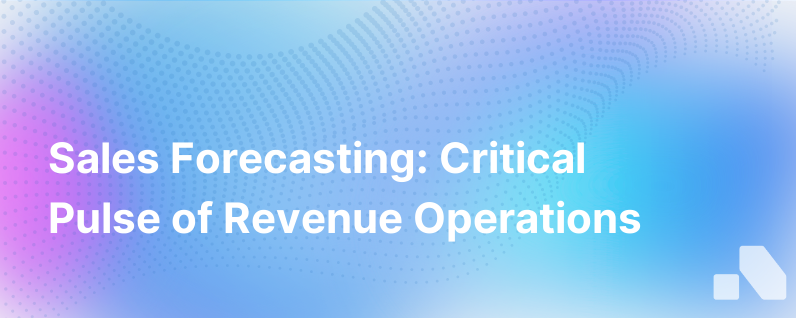
Sales forecasting isn't just a metric; it is the heartbeat of a company’s revenue operations. Like a heartbeat, it sustains and gives life to every part of the sales and revenue strategy. It measures the health of the business and future financial prospects. With precision forecasting, a business can make informed decisions about growth, resource allocation, and risk management.
In this deep dive, we'll explore the nuances of sales forecasting and how it becomes the driving force behind a robust revenue operational strategy.
Understand the Essence of Sales Forecasting
Sales forecasting is the process of estimating future sales. Accurate sales forecasts enable you to predict short-term and long-term performance, making them essential for managing and sustaining business operations. It's a forward-looking metric using historical data, market analysis, and sales trends to predict future revenues.
Without forecasting, a business may as well be navigating without a map, unable to foresee terrain changes, weather shifts, or obstacles that lie ahead.
Why is Sales Forecasting So Vital?
Several functions of the business depend heavily on sales forecasting:
- Budgeting: It informs budget allocation across departments.
- Cash Flow Management: It's imperative for accurately predicting cash flow needs.
- Goal Setting: It aligns sales targets across the organization.
- Resource Allocation: It determines where staff, funds, and efforts should be channelled.
- Performance Measurement: It's the yardstick for assessing sales team performance.
- Pipeline Management: Effective forecasting enables sales leaders to prioritize leads and opportunities diligently.
- Risk Management: It aids in the identification of potential risks in the sales pipeline and the broader market.
- Investor Relations: It instills confidence in investors and stakeholders with transparent and predictable future revenue paths.
In essence, forecasting stands at the confluence of strategic planning and tactical adjustment.
The Four Pillars of Effective Sales Forecasting
1. Analyzing Historical Data
Forecasting is not just about looking into a crystal ball and making predictions. It starts with analyzing historical data. When done correctly, this historical analysis is the foundation on which a credible forecast is built. This includes scrutinizing sales cycles, win rates, seasonality effects, and customer behaviors.
2. Understanding the Sales Pipeline
A clear understanding of the sales pipeline and where each prospect stands is invaluable to forecast accuracy. It involves evaluating pipeline velocity, pinpointing where prospects are getting stuck, and assessing the probability of deals closing.
3. Utilizing Predictive Analytics
Advanced forecasting models use predictive analytics, leveraging data science to forecast future sales outcomes based on current pipeline data and trends. This method grows more precise with the accumulation and analysis of more data.
4. Continuous Review and Adaptation
Circumstances change, markets fluctuate, and prospect needs evolve. Continuous review and adaptation of the forecast methodology are crucial to maintaining its relevance and accuracy. It necessitates a cyclical process of planning, analyzing, executing, and reviewing.
Quantitative vs. Qualitative Forecasting Methods
There are two main types of forecasting methods: quantitative and qualitative. Quantitative forecasting is data-driven, relying on numerical data to predict future sales, while qualitative forecasting relies on subjective approaches, including expert opinions and market research.
In practice, the most accurate forecasting often results from a combination of both methods, harnessing the power of data while considering the qualitative insights gained from the experience and proficiency of the sales team.
Common Forecasting Models
Sales forecasting models range from simple to sophisticated including:
- Straight-line Method: Uses consistent growth rate to forecast.
- Moving Average: Forecasts sales based on the average of past sales data.
- Regression Analysis: Finds relationships between sales and other factors.
- Pipeline Forecasting: Based on the sales pipeline's status, size, and expected close date.
Each has different applicability depending on the business's complexity, industry, and available data.
Challenges in Sales Forecasting
The success of sales forecasting is often hindered by several challenges:
- Data Quality: Poor or incomplete data cripples forecasting effectiveness.
- Sales Cycle Complexity: Longer and multi-faceted sales cycles make forecasting more difficult.
- Market Volatility: Changes in market conditions can upend forecasts.
- Human Error: Overly optimistic or conservative predictions by sales representatives can skew forecasts.
Overcoming these challenges calls for robust data management, training, and an adaptable approach to forecasting.
Embracing Technology in Forecasting
In this day and age, technology is an inextricable component of effective sales forecasting. AI platforms like Aomni automate data analysis, offer predictive insights, and update forecasts in real-time. Technology ensures the reduction of human error and biases, providing a more structured and accurate outlook.
The Bottom Line
When performed effectively, sales forecasting is not merely a passive report generated each quarter. It is an active management tool that informs almost every critical business decision.
A refined forecasting process gives the leadership team a powerful lens through which they can peer into the future of the business, making real-time adjustments to ensure revenue operations function at their peak efficiency.
In summary, sales forecasting is less a peripheral metric and more a central system. It is a disciplined approach to predicting the future, enabling startups to grow confidently and methodically.
In an ideal world, every B2B startup would have access to a forecasting guru - someone to navigate the uncertainties of growth and market dynamics. In our world, Aomni offers the next best thing. With comprehensive real-time account research, competitive insights, and AI-powered personalized content, Aomni transforms forecasting from an educated guess into a strategic advantage, making the heartbeat of revenue operations stronger and more predictable.